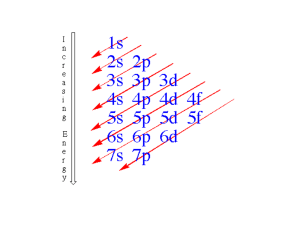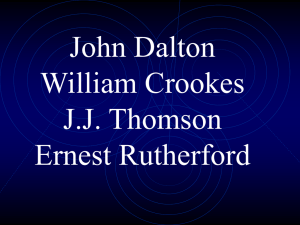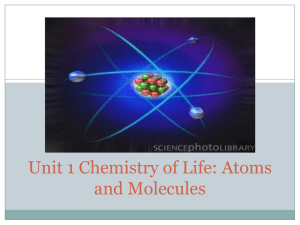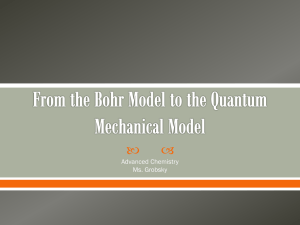Polyelectronic atoms
advertisement
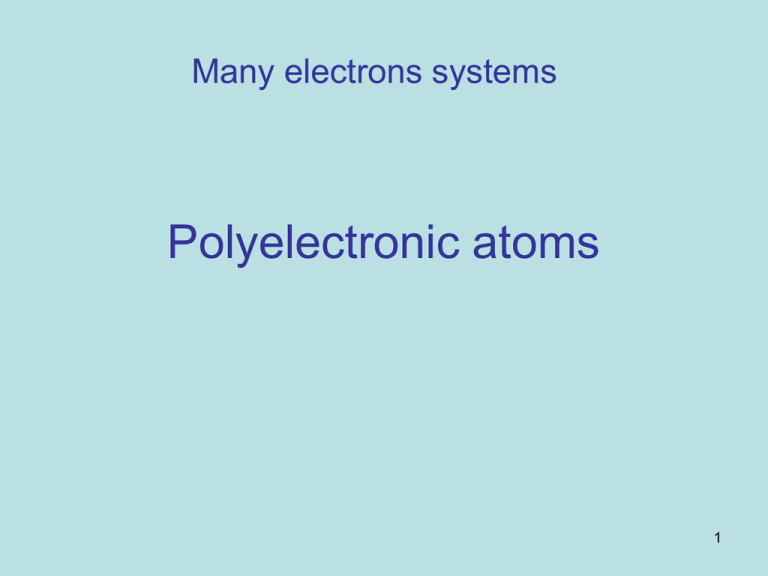
Many electrons systems Polyelectronic atoms 1 Two-electron atoms Electron 2 électron Electron électron 1 -e 1 r 12 2 -e r2 r1 noy au +Ze Nucleus +Ze Write the Schrödinger Equation for He or Li+ 2 Two-electron atoms Electron 2 électron Electron électron 1 -e 1 r 12 2 -e r2 r1 noy au +Ze Nucleus +Ze T V E 3 T is positive V contains positive and negative contributions Attraction: negative Attraction: negative repulsion: positive E is negative (for bounded states) 4 T1 acts on e1 and does not on e2 T2 acts on e2 and does not on e1 V contains positive and negative contributions Vn,e1 acts on e1 and does not on e2 Vn,e2 acts on e2 and does not on e1 Ve1,e2 acts on both This is the difficult part that couples electrons. The coupling of the electron is called “the electronic correlation”. Each electron depends on the position of the other electron (not only on its average distribution). 5 First approach: Complete neglect of Ve1,e2 Consequence: We neglect a repulsion overestimation of the atom stability Atomic orbitals are solutions for one electron: Y1s Let try the product of two orbitals: Y1s2 = Y1s(e1) Y1s(e2) Sum of monoelectronic operators Sum 6 Conclusions Orbitalar Approximation •The atomic wave function is a 2-electron function. •The product of two orbitals (1-e function) is a solution •The corresponding energy is the sum of the energies. Y1s2s (e1,e2) = Y1s(e1) Y2s (e2) E = E1s + E2s 1s2s is an atomic configuration. Its energy is higher than that for 1s2 1s2 is the ground state; 1s2s is an excited state 7 Ionization Potential He He+ He+ + eHe2+ + e- IP = 24.5 eV IP = 54.4 eV The second IP is that of the hydrogenoid: Z2(-13.6) eV = 54.4 eV no approximation The first IP is wrong ! Electron Affinity AA + eEA = IP of the negative ion Defined to be positive when the anion is stable HH + e- = 0.77 eV not equal to 13.6 eV 2-e repulsion differs EA may be positive or negative 8 Second approach: Ve1,e2 replaced by it mean value: -5/4 Z (E1sH) Replacing the repulsion by a constant still allows the orbitalar approximation -5/4Z(13.6) is a constant and do not depend on the electron position. The first IP = 20.4 eV (24.5 eV) experimentally The second IP is again that of the hydrogenoid 9 Third approach: The Slater Model Each monoelectronic operator is the hamiltonian for the hydrogenoid, replacing Z by Z*=Z-s = 2 (Z-s)2 E1s(H) = - 77.69 eV IP = 23.29 eV assuming s= 0.31 10 The atom with many electrons Orbitalar approximation : Every wave function describing a polyelectronic atom will be expressed as a product of atomic orbitals. The expression f1s(1) f1s(2) f2s(3) f2s(4) f2p(5) f2p(6)… describes an atomic configuration. We neglect the electronic correlation. Electrons are not coupled. We neglect part of the antisymmetry that should respect the polyelectronic wave function: f1s(1) f1s(2) - f1s(2) f1s(1) The exchange of two electrons should give the same expression changing sign. A requirement for the Pauli Principle 11 Four rules to determine the atomic configurations for the ground state •The Pauli principle: fundamental principle of physics = always verified •The principle of stability. Just commonsense. Obvious to have the ground state •The Klechkovsky rule. Practical. Necessary to order the atomic levels. Many exceptions •The Hund rule (s). To remind that for high spin states, one of them is lower in energy Pauli principle: Two different electrons cannot be in the same state (Two electrons cannot have the same four quantum numbers). This imposes the maximum occupancy for orbitals and spin-orbitals. One orbital is occupied by no more than 2 electrons (with opposite spin). When occupied a spin-orbital has only one electron. 12 The Slater model John Clarke Slater (1900-1976) Generalization of the method used for 2-electrons Requires defining the screen factors, s Allows respecting the Pauli principle and the principle of stability It provides its own ordering of atomic levels. Z* = Z - Ss Sum over the n-1 electrons screening the one that we consider 13 Screening factors Screening Electron i are classified in families: I1sI2spI3spI3dI4spI4dI… No distinction between s and p i i j Electron j in which we are interested If i is inside (closer) it is screening If i is outside, it has no influence (Gauss theorem) s ranges from 1 to 0. 14 Screening factors Screening Electron i Electron j in which we are interested 15 We thus calculate atomic orbitals, orbital energies and orbital radii. Summing electron contributions, we calculate atomic properties Application IP for C C → C+ + eIP = E(C+)-E(C) 1s22s22p1 1s22s22p2 16 We thus calculate atomic orbitals, orbital energies and orbital radii. Summing electron contributions, we calculate atomic properties Application IP for C C → C+ + eIP = E(C+)-E(C) E2p 1s22s22p1 1s22s22p2 The atomic functions have the same shape but differ ! 17 C → C+ + eIP = E(C+)-E(C) 1s22s22p1 1s22s22p2 Here the 1s2 contribution is the same (modification in the valence shell only) The 2sp in 2s22p1 energy differs from the 2sp one in 2s22p2 There have not the same Z* Z characterizes the nucleus charge Not the number of electrons It never varies 18 C → C+ + eIP = E(C+)-E(C) 1s22s22p1 1s22s22p2 Here the 1s2 contribution is the same (modification in the valence shell only) The 2sp in 2s22p1 energy differs from the 2sp one in 2s22p2 There have not the same Z* # of electron in the shell varies # of electron in the shell Varies minus the one considered - varies 19 C and C+ orbitals Z characterizes the nucleus charge And not the number of electrons Never varies 20 C and C+ orbitals # of electron in the shell minus the one considered - varies 21 trends Z* increases for negatively charged species Z* increases for orbitals of the same shell n → n+1 Z* → Z*+(1-s) Energy decrease with n* Slater values originate from an ab initio energy minimization (variation principle). Effective quantum number n 1 2 3 4 5 6 n* 1 2 3 3.7 4 4.2 22 The Klechkovsky rule This rule provides a more reliable ordering of the atomic levels than using the Slater model. It helps building the Mendeleev table. It is not always satisfied. The atomic orbitals are ordered according to n+l values For equivalent n+l, they are ordered according to n values: first smaller n (larger l) 23 The Klechkovsky rule n s p d f 1s l=0 l=1 l=2 l=3 1 1 2 2 3 3 3 4 5 4 4 5 6 7 5 5 6 7 8 6 6 7 8 9 2s 2p 3s 3p 3d 4s 4p 4d 4f 5s 5p 5d 5f Table of n + l values 6s 6p 24 Exceptions to the Klechkovsky rule 22s22p63s23p63d104s24p64d10 Pd IS 1s 46 IS NOT 1s22s22p63s23p63d104s24p64d85s2. Filled d band explains; however Ni is 3d84s2 and Pt is 5d96s1 Noble metal atoms: Cu is 3d104s1 Ag 4d105s1 and 5d106s1 Properties are close to alkali 25 Hund(s) rule When the filling of a shell is incomplete, ground states are high spin states with the maximum number of electrons with the same spin. 2s 2p C No order among the p levels here 26 Paramagnetism - diamagnetism Diamagnetism = closed shell systems Paramagnetism = open shell systems Is an atom with an even number of electron necessarily diamagnetic? Is an atom with an odd number of electron necessarily paramagnetic? What is the (l, ml) values for Lithium? Is Li dia or para? Why? 27 Periodicity from IPs Extraction of s orbitals marks a periodic discontinuity (see H, Li, Na, K, Cs and Rb). We place on the same column these atoms. The number of electrons in the row (period) is the number of valence electrons. The electrons of the previous rows 28 are core electrons lines Start a new period filling each new ns type orbital columns Isolobal compounds are placed in a same column Column c: 1-2 3-12 13-18 Configuration: nsc ns2(n-1)dc-2 ns2(n-1)d10npc12 29 Building the Mendeleev table 1s2 2s22p6 3s23p6 4s23d104p6 5s24d105p6 6s24f145d106p6 7s25f146d107p6 configuration 2 +8 =10 +8 = 18 +18 = 36 +18 = 54 +32 = 86 +32 = 118 number of e core electrons for the next period Total number of electrons = Z (for atoms) core 2-10-18-36-54-86 + of the rare gas valence n° of column 30 alkaline Alkaline earth Transition metals http://www.webelements.com/ Noble metals Halogens Rare gases 31 Where is Ga(Z=31) in the table? Where is Hg(Z=80) in the table? 32 Where is Ga(Z=31) in the table? Column 13 31 = 18 + 13 18<31<36 Row 4 Where is Hg(Z=80) in the table? Column 12 80 = 54 + 14 + 12 54<80<86 Row 6 f electrons 33 Trends deduced from the Slater model Electronegativity increases from left to right Z* increases for orbitals of the same shell n → n+1 Z* → Z*+(1-s) for Na: Z*=11-8x0.85-2=2.2 E=2.22/32 (E1sH) = -7.31 eV For Cl: Z*=17-6x0.35-8x0.85-2=6.1 E=6.12/32 (E1sH) = -56.2 eV Electronegativity decreases from top to bottom Compare Na with K: for Na: Z*=11-8x0.85-2=2.2 E=2.22/32 (E1sH) = -7.31 eV For K: Z*=19-8x0.85-10=2.2 E=2.22/3.72 (E1sH) = -4.81 eV Energy decrease with n* 34 IP from Slater 30 Pot ent iel d'ionis at ion ( eV) Valeurs expériment ales Ionization potentials Hunds rule 20 n=2 10 n=3 nombre d'élect ron de v alence Number of valence electrons Completely filled column 0 1 2 3 4 5 6 7 8 35 D. Mendelejeff, Zeitschrift für Chemie 12, 405-6 (1869) The opposite orientation of now By ordering the elements according to increasing atomic weight in vertical rows so that the horizontal rows contain analogous elements, still ordered by increasing atomic weight, one obtains the following arrangement, from which a few general conclusions may be derived. 1. The elements, if arranged according to their atomic weights, exhibit a periodicity of properties. 2. Chemically analogous elements have either similar atomic weights (Pt. Ir, Os), or weights which increase by equal increments (K, Rb, Cs). 3. The arrangement according to atomic weight corresponds to the valence of the element and to a certain extent the difference in chemical behavior, for example Li, Be, B, C, N, O, F. 36 4. The elements distributed most widely in nature have small atomic weights, and all such elements are marked by the distinctness of their behavior. They are, therefore, the representative elements; and so the lightest element H is rightly chosen as the most representative. 5. The magnitude of the atomic weight determines the properties of the element. Therefore, in the study of compounds, not only the quantities and properties of the elements and their reciprocal behavior is to be taken into consideration, but also the atomic weight of the elements. Thus the compounds of S and Tl [Te was intended], Cl and J, display not only many analogies, but also striking differences. 6. One can predict the discovery of many new elements, for example analogues of Si and Al with atomic weights of 65-75. 7. A few atomic weights will probably require correction; for example Te cannot have the atomic weight 128, but rather 123-126. 8. From the above table, some new analogies between elements are revealed. Thus Bo [Ur was intended] appears as an analogue of Bo and Al, as is well known to have been long established experimentally. 37 Better than just a classification, a periodic table! An unknown compound predicted ? M=78.2 V=19 density=4.6 Se M=78.8 V=17.2 density=4.6 Dmitri Mendeleev Russian (Siberia – St Petersbourg) (1834 - 1907) S As ? Br Te 38 127 126 59 58 52Te 53I 27Co 28Ni Dmitri Mendeleev Russian (Siberia – St Petersbourg) (1834 - 1907) Switch between atom classification because of chemistry (valency) 39 Antoine Laurent Lavoisier (1743-1794) Better, than a list a classification 40 Antoine Lavoisier (1743-1794) Better, than a list a classification He classified the known elements into four groups: Elastic fluids Lavoisier included light, heat, oxygen, nitrogen, and hydrogen in this group. Nonmetals This group includes "oxidizable and acidifiable nonmetallic elements". Lavoisier lists sulfur, phosphorus, carbon, hydrochloric acid, hydrofluoric acid, and boric acid. Metals These elements are "metallic, oxidizable, and capable of neutralizing an acid to form a salt." They include antimony and arsenic (which are not considered metals today), silver, bismuth, cobalt, copper, tin, iron, manganese, mercury, molybdenum, nickel, gold, platinum, lead, tungsten, and zinc. Earths Lavoisier's salt-forming earthy solid "elements" included lime, magnesia 41 (magnesium oxide), baryta (barium oxides), alumina (aluminum oxide), and silica (silicon dioxide). Forming ions is endothermic except if environment is stabilizing Na 1 électron à -7.31 eV Energy loss 1.23 EV (Slater) Cl - 1.53 eV exp. Cl 8 électrons à -49.96 eV In a dipole (d=2.56 a0) the stabilizing energy is 10.63 eV 7 électrons à -56.23 eV 42 Atomic orbital levels E = - IP Tjalling C. Koopmans Dutch Nobel Prize in Economic Sciences in 1975 1s 2s 2p H He 13.6 24.25 Li Be B C N O F 58 115 192 268 406 538 654 5.4 9.3 12.9 16.6 20.3 28.5 37.9 8.3 11.3 14.5 13.6 18.4 43 Values from Extended Hückel (-eV) 2s H 13.6 Li 5.4 He 24.25 Be 10 B 15.2 C 21.4 N 26 O 32.3 F 40 2p 3.5 6 8.5 11.4 13.4 14.8 18.1 Na Mg Al Si P S Cl 3s 5.1 9 12.3 17.3 18.6 20 30 3p 3. 4.5 6.5 9.2 14 13.3 15 1s Roald Hoffmann 44 Is abundance of atoms related to their stability? Why? What are the most abundant atoms on the earth surface? In the human body? 45 Relative abundance of elements on earth crust 46 O ppb by weight Abundance ppb by atoms Universe 10000000 800000 Sun 9000000 700000 Meteorite (carbonaceous) 410000000 480000000 Crustal rocks 460000000 600000000 Sea water 857000000 331000000 Stream 880000000 55000000 Human 610000000 240000000 C Si Abundance ppb by weight ppb by weight ppb by atoms Universe 5000000 500000 Sun 3000000 300000 Meteorite (carbonaceous) 15000000 18000000 Crustal rocks 1800000 3100000 Sea water 28000 14400 Stream 1200 100 Human 230000000 120000000 Abundance ppb by atoms Universe 700000 30000 Sun 900000 40000 Meteorite (carbonaceous) 140000000 100000000 Crustal rocks 270000000 200000000 Sea water 1000 220 Stream 5000 180 Human 260000 58000 47 Abundance (masses) in human body; the human body is made of 65 to 90% of water element abundance Carbon 18% Hydrogen 10% Nitrogen 3% Calcium 1.5% Phosphorus 1.0% Potassium 0.35% Sulfur 0.25% Sodium 0.15% Magnesium 0.05% Copper, Zinc, Selenium, Molybdenum, Fluorine, Chlorine, Iodine, Manganese, Cobalt, Iron 0.70% Lithium, Strontium, Aluminum, Silicon, Lead, Vanadium, Arsenic, Bromine trace amounts 48 Atom formation • It is not related to the stability (otherwise rare gas atoms would be abundant) • It results from the formation of the nuclei The big bang story 49 4 steps after the big bang about 13.7 billion years ago. • 1) 0-100 seconds after George Gamow in 1948 Russian-American 1904-1968 – T is cooling and particles form. There are many particles in a confined space. They meet to form nuclei (later on after expansion it will not be possible; after 3 minutes space is too dilute for nuclear reactions) – Universe contains a lot of hn that destroy nuclei. (109 for 1 H+); only H and He nuclei are formed. • 2) 300 000 years after – T is still cooling. Radiations become ineffective. H and He atoms are formed. They still represent 98% of the mass of the 50 universe (1 He for 12 H everywhere) 4 steps after the big bang • 3) 30 000 000 000 years – Stars are formed because of gravitation – They are atom foundries – Atoms are unstable because of shocks. Nuclei meet again and form larger ones – 3 He make a C (occurrence is weak but time is long in a confined space: combustion of H forming He takes 9000 millions of years; that of He to C, 300 millions of years – Fusion are exothermic up to Z=26 (Fe) thus elements (Z =1-100) are made. Beyond Z=26, the star uses its own energy. After a while, stars die 51 4 steps after the big bang • 4) Stars explose in supernova. – Pieces of Stars feed the universe. Heavy atoms represent 2% of the total – Universe is cold and atoms are stable; they gather to make molecules and condense into new stars and planets. 52 53




